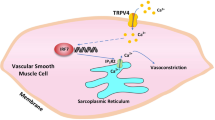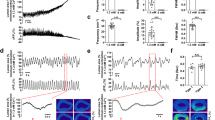Abstract
Relaxation of the corpus cavernosum smooth muscle is an absolute prerequisite for penile erection. Potassium channels play a role in the physiologic regulation of corporal smooth muscle tone. In spite of the physiological importance of KATP channel in the modulation of corporal smooth muscle tone, there is a shortage of information available about the KATP channel subtype(s) present in the corporal smooth muscle. The purpose of this study was to investigate the subunit type of KATP channel, that is, the combinations of the Kir subunit and the SUR subunit in the human corporal smooth muscle and determine whether the electrophysiological kinetics and pharmacological properties of KATP channels meet the subunit characteristics of the ion channel. We used cultured human corporal smooth muscle cells. To determine the presence of Kir and SURs subunits, RT-PCR was performed using Kir6.1, Kir6.2, SUR1, SUR2A, and SUR2B gene-specific primers. For electrophysiological recordings, the whole-cell, inside-out, and cell-attached configurations of the patch-clamp technique were used. We observed transcripts for Kir6.1, Kir6.2, and SUR2B in mRNA isolated from smooth muscle cells of cultured human corpus carvernosum. We recorded the unitary KATP channel under the condition of intracellular and extracellular 140 mM [K+], and the slope conductance of the channel was 42.0±2.6 pS which is an intermediate conductance between that of either Kir6.1 or Kir6.2. The pinacidil (10 μM) increased the magnitude of the outward K+ current (214.6±89.2%, n=12, P<0.05), which was blocked by the subsequent addition of the specific KATP channel subtype selective blocker, glibenclamide (10 μM). The SIN-1(200 μM) induced increases in whole-cell outward K+ currents (126.0±1.4%, n=4). The increased currents by SIN-1 were inhibited by glibenclamide (10 μM). We are the first to show that KATP channel in human corporal smooth muscle is composed of Kir6.1–Kir6.2 construct expressed with SUR2B by RT-PCR. These findings, taken together with the electrophysiological results, suggest that KATP channel in corporal smooth muscle cells is composed of heteromultimers of Kir6.1 and Kir6.2 with the ratio of 3 : 1 or 4 : 0 and SUR2B.
This is a preview of subscription content, access via your institution
Access options
Subscribe to this journal
Receive 8 print issues and online access
$259.00 per year
only $32.38 per issue
Buy this article
- Purchase on Springer Link
- Instant access to full article PDF
Prices may be subject to local taxes which are calculated during checkout







Similar content being viewed by others
References
Yokoshiki H, Sunagawa M, Seki T, Sperelakis N . ATP-sensitive K+ channels in pancreatic, cardiac, and vascular smooth muscle cells. Am J Physiol 1998; 274: C25–C37.
Christ GJ, Spray DC, Brink PR . Characterization of K currents in cultured human corporal smooth muscle cells. J Androl 1993; 14: 319–328.
Fan SF et al. An analysis of the Maxi-K+ (KCa) channel in cultured human corporal smooth muscle cells. J Urol 1995; 153: 818–825.
Nelson MT . Ca2+-activated potassium channels and ATP-sensitive potassium channels as modulators of vascular tone. Trends Cardiovasc Med 1993; 3: 54–60.
Nelson MT, Patlak JB, Worley JF, Standen NB . Calcium channels, potassium channels, and voltage dependence of arterial smooth muscle cell tone. Am J Physiol 1990; 259: C13–C18.
Giraldi A, Wagner G . Effects of pinacidil upon penile erectile tissue, in vitro and in vivo. Pharmacol Toxicol 1990; 67: 235–238.
Venkateswarlu K et al. Potassium channels and human corporeal smooth muscle cell tone: diabetes and relaxation of human corpus cavernosum smooth muscle by adenosine triphosphate sensitive potassium channel openers. J Urol 2002; 168: 355–361.
Palmer L et al. Characterization of cAMP accumulation in cultured human corpus cavernosum smooth muscle cells. J Urol 1994; 152: 1308–1314.
Zhao W, Christ GJ . Endothelin-1 as a putative modulator of erectile dysfunction. II. Calcium mobilization in cultured human corporal smooth muscle cells. J Urol 1995; 154: 1571–1579.
Campos de Carvalho et al. Gap junctions formed of connexin43 interconnect smooth muscle cells of the human corpus cavernosum. J Urol 1993; 149: 1568–1575.
Andersson KE . Clinical pharmacology of potassium channel openers. Pharmacol Toxicol 1992; 70: 244–254.
Brayden JE, Nelson MT . Regulation of arterial tone by activation of calcium dependent potassium channels. Science 1992; 256: 532–535.
Lee SW, Wang H-Z, Christ GJ . Characterization of KATP channel subtypes in cultured human corporal smooth muscle cells. Int J Impot Res 1999; 11: 179–188.
Koh SD et al. Basal activation of ATP-sensitive potassium channels in murine colonic smooth muscle cell. Biophys J 1998; 75: 1793–1800.
Gopalakrishnan M et al. Characterization of the ATP-sensitive potassium channels (KATP) expressed in guinea pig bladder smooth muscle cells. J Pharmacol Exp Ther 1999; 289: 551–558.
Inagaki N et al. Reconstitution of IK(ATP): an inward rectifier subunit plus the sulfonylurea receptor. Science 1995; 270: 1166–1170.
Chutkow WA et al. Cloning, tissue expression, and chromosomal localization of SUR2, the putative drug-binding subunit of cardiac, skeletal muscle, and vascular KATP channels. Diabetes 1996; 45: 1439–1445.
Inagaki N et al. Cloninig and functional characterization of a novel ATP-sensitive potassium channel ubiquitously expressed in rat tissues, including pancreatic islets, pituitary, skeletal muscle, and heart. J Biol Chem 1995; 270: 5691–5694.
Okuyama Y et al. The effects of nucleotides and potassium channel openers on the SUR2A/Kir6.2 complex K+ channel expressed in a mammalian cell line, HEK293T cells. Pflügers Arch 1998; 435: 595–603.
Akao M et al. Myocardial ischemia induces differential regulation of KATP channel gene expression in rat hearts. J Clin Invest 1997; 100: 3053–3059.
Lu C, Halvorsen SW . Channel activators regulate ATP-sensitive potassium channel (KIR6.1) expression in chick cardiomyocytes. FEBS Lett 1997; 412: 121–125.
Babenko AP, Gonzalez GC, Bryan J . Hetero-concatemeric Kir6.X4/SUR14 channels display distinct conductivities but uniform ATP inhibition. J Biol Chem 2001; 275: 31563–31566.
Kono Y et al. The properties of the Kir6.1–6.2 tandem channel coexpressed with SUR2A. Pflüegers Arch 2000; 440: 692–698.
Suzuki M et al. Kir6.1: a possible subunit of ATP-sensitive K+ channels in mitochondria. Biochem Biophys Res Commun 1997; 241: 693–697.
Kondo C et al. Chimeras of Kir6.1 and Kir6.2 reveal structural elements involved in spontaneous opening and unitary conductance of the ATP-sensitive K+ channels. Receptors Channels 1998; 6: 129–140.
Acknowledgements
This work was supported by Korea Research Foundation Grant (KRF-2000-041-F00237).
Author information
Authors and Affiliations
Rights and permissions
About this article
Cite this article
Insuk, S., Chae, M., Choi, J. et al. Molecular basis and characteristics of KATP channel in human corporal smooth muscle cells. Int J Impot Res 15, 258–266 (2003). https://doi.org/10.1038/sj.ijir.3901013
Received:
Revised:
Accepted:
Published:
Issue Date:
DOI: https://doi.org/10.1038/sj.ijir.3901013
Keywords
This article is cited by
-
Effects of ethanol on the tonicity of corporal tissue and the intracellular Ca2+ concentration of human corporal smooth muscle cells
Asian Journal of Andrology (2010)
-
The effects of dopamine receptor agonists on BKCa channels and signal transduction mechanism in corpus cavernosal smooth muscle cells
International Journal of Impotence Research (2008)
-
Involvement of α-receptors and potassium channels in the mechanism of action of sildenafil citrate
International Journal of Impotence Research (2007)
-
Lysophosphatidylcholine, a component of atherogenic lipoproteins, induces the change of calcium mobilization via TRPC ion channels in cultured human corporal smooth muscle cells
International Journal of Impotence Research (2005)



